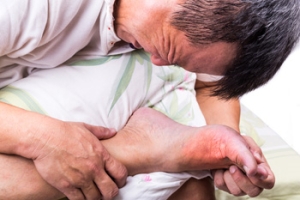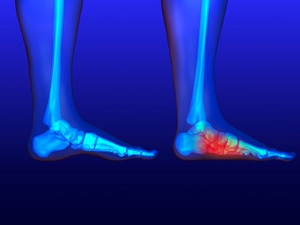Port Neches, TX (409) 727-1122

Eating Certain Types of Foods May Trigger Gout Attacks
 The medical condition that is referred to as gout is considered to be a form of arthritis. Common symptoms of this ailment often consist of severe pain and discomfort in the joints of the big toe. The pain can be debilitating, and it may be difficult to complete daily activities. Gout can develop as a result of having elevated uric acid levels in the blood, which generally happens due to high purine levels. This can happen as a result of genetic factors, from eating foods such as shellfish and red meat, and from drinking excessive alcohol. Additionally, it may occur in patients who are obese, or who have chronic kidney disease. Research has indicated that it may be beneficial to implement healthy eating habits into your daily routine, as this may limit the amount of gout attacks. If you have frequent bouts of gout, it is suggested that you consult with a podiatrist who can offer you prevention and treatment options.
The medical condition that is referred to as gout is considered to be a form of arthritis. Common symptoms of this ailment often consist of severe pain and discomfort in the joints of the big toe. The pain can be debilitating, and it may be difficult to complete daily activities. Gout can develop as a result of having elevated uric acid levels in the blood, which generally happens due to high purine levels. This can happen as a result of genetic factors, from eating foods such as shellfish and red meat, and from drinking excessive alcohol. Additionally, it may occur in patients who are obese, or who have chronic kidney disease. Research has indicated that it may be beneficial to implement healthy eating habits into your daily routine, as this may limit the amount of gout attacks. If you have frequent bouts of gout, it is suggested that you consult with a podiatrist who can offer you prevention and treatment options.
Gout is a painful condition that can be treated. If you are seeking treatment, contact Pete O’Donald, DPM from Texas. Our doctor will treat your foot and ankle needs.
What Is Gout?
Gout is a form of arthritis that is characterized by sudden, severe attacks of pain, redness, and tenderness in the joints. The condition usually affects the joint at the base of the big toe. A gout attack can occur at any random time, such as the middle of the night while you are asleep.
Symptoms
- Intense Joint Pain - Usually around the large joint of your big toe, and it most severe within the first four to twelve hours
- Lingering Discomfort - Joint discomfort may last from a few days to a few weeks
- Inflammation and Redness -Affected joints may become swollen, tender, warm and red
- Limited Range of Motion - May experience a decrease in joint mobility
Risk Factors
- Genetics - If family members have gout, you’re more likely to have it
- Medications - Diuretic medications can raise uric acid levels
- Gender/Age - Gout is more common in men until the age of 60. It is believed that estrogen protects women until that point
- Diet - Eating red meat and shellfish increases your risk
- Alcohol - Having more than two alcoholic drinks per day increases your risk
- Obesity - Obese people are at a higher risk for gout
Prior to visiting your podiatrist to receive treatment for gout, there are a few things you should do beforehand. If you have gout you should write down your symptoms--including when they started and how often you experience them, important medical information you may have, and any questions you may have. Writing down these three things will help your podiatrist in assessing your specific situation so that he or she may provide the best route of treatment for you.
If you have any questions, please feel free to contact our office located in Nederland, TX . We offer the newest diagnostic and treatment technologies for all your foot care needs.
Gout
Gout is a form of arthritis that is caused by a buildup of uric acid crystals in the joints. This considered to be one of the most frequently recorded medical illnesses throughout history. Gout occurrences in the US have risen within the past twenty years and the condition now affects 8.3 million people which is 4% of all Americans. Researchers have found that gout affects men more than women and African-American men more than white men.
Symptoms of gout are warmth, swelling, discoloration, and tenderness in the affected joint area. The small joint on the big toe is the most common place for a gout attack to occur.
People who are obese, gain weight excessively, drink alcohol heavily, have high blood pressure, or have abnormal kidney function are more likely to develop gout. Furthermore, certain drugs and diseases are likely to increase levels of uric acid in the joints which eventually leads to gout. You are also more likely to develop gout if you eat a lot of meat and fish.
Many who experience gout attacks will experience repeated attacks over the years. Some people who have gout symptoms, may never have them again, but others may experience them several times a year. If you have gout symptoms throughout the year, you may have recurrent gout. Those who have gout should also be careful about their urate crystals collecting in their urinary tract, because this may lead to kidney stones.
Diagnosis for gout is done by checking the level of uric acid in the joints and blood. Your podiatrist may also prescribe medicine to reduce uric acid buildup in the blood, which will help prevent any gout attacks.
To treat gout, your podiatrist may also prescribe you Anti-inflammatory medication (NSAIDs) which will relieve the pain and swelling of a gout episode and it can also shorten a gout attack. Maintaining a healthy diet is also a proven method to prevent gout attacks.
Common Foot Injuries Experienced by Basketball Players
 Basketball is a sport that, while played professionally, is also often played year round by average people. While it is not considered a collision sport like football or hockey, basketball is considered a contact sport and has one of the highest injury rates when compared to other sports. The most common basketball injury is an ankle sprain due to the side to side movements and potential to land wrong while jumping. Proper stretching and strengthening are important to lower the risk of injury, especially since an ankle sprain is likely to reoccur. Achilles tendon injuries are also common in basketball due to the large amount of stress placed on the tendon. Overuse can result in Achilles tendinitis and tendinosis, and Achilles tendon ruptures are possible as well. Proper stretching of the calves is key to helping reduce the chances of an injury. If you believe that you have experienced an injury to your foot while playing basketball, it is important to consult with a podiatrist for a proper diagnosis and treatment plan.
Basketball is a sport that, while played professionally, is also often played year round by average people. While it is not considered a collision sport like football or hockey, basketball is considered a contact sport and has one of the highest injury rates when compared to other sports. The most common basketball injury is an ankle sprain due to the side to side movements and potential to land wrong while jumping. Proper stretching and strengthening are important to lower the risk of injury, especially since an ankle sprain is likely to reoccur. Achilles tendon injuries are also common in basketball due to the large amount of stress placed on the tendon. Overuse can result in Achilles tendinitis and tendinosis, and Achilles tendon ruptures are possible as well. Proper stretching of the calves is key to helping reduce the chances of an injury. If you believe that you have experienced an injury to your foot while playing basketball, it is important to consult with a podiatrist for a proper diagnosis and treatment plan.
Sports related foot and ankle injuries require proper treatment before players can go back to their regular routines. For more information, contact Pete O’Donald, DPM of Texas. Our doctor can provide the care you need to keep you pain-free and on your feet.
Sports Related Foot and Ankle Injuries
Foot and ankle injuries are a common occurrence when it comes to athletes of any sport. While many athletes dismiss the initial aches and pains, the truth is that ignoring potential foot and ankle injuries can lead to serious problems. As athletes continue to place pressure and strain the area further, a mild injury can turn into something as serious as a rupture and may lead to a permanent disability. There are many factors that contribute to sports related foot and ankle injuries, which include failure to warm up properly, not providing support or wearing bad footwear. Common injuries and conditions athletes face, including:
- Plantar Fasciitis
- Plantar Fasciosis
- Achilles Tendinitis
- Achilles Tendon Rupture
- Ankle Sprains
Sports related injuries are commonly treated using the RICE method. This includes rest, applying ice to the injured area, compression and elevating the ankle. More serious sprains and injuries may require surgery, which could include arthroscopic and reconstructive surgery. Rehabilitation and therapy may also be required in order to get any recovering athlete to become fully functional again. Any unusual aches and pains an athlete sustains must be evaluated by a licensed, reputable medical professional.
If you have any questions please feel free to contact our office located in Nederland, TX . We offer the newest diagnostic and treatment technologies for all your foot and ankle needs.
Sports Related Foot And Ankle Injuries
Foot and ankle injuries are common among people who participate in sports. Several factors contribute to this. They include failing to stretch or warm up properly, not wearing the proper type of shoe and not taping or providing other types of support for the ankle or foot. The most common foot and ankle injuries suffered by people involved in sports are plantar fasciitis, ankle sprains and Achilles tendon damage or ruptures. If not treated properly, they can lead to permanent disability.
Treating these injuries is relatively simple if they are identified and addressed early. Many athletes dismiss the initial aches and pains associated with injury as just soreness or tired muscles. Their first response is usually to try to work through it. This can lead to serious problems. Many minor injuries are made far more serious when athletes continue to put strain and pressure on them. That attitude can change a mild strain into a serious strain and a minor tear into a rupture. Athletes should have unusual aches and pains evaluated by a skilled medical professional.
Plantar fasciitis is a painful injury. It is inflammation of the plantar fascia, the thick band of tissue running from the heel to the base of the toes. If left untreated, it can lead to a degenerative disease called plantar fasciosis. There are several effective treatments for this ailment. Doctors often prescribe rest, massages, stretching, night splints, physical therapy, anti-inflammatory medication, corticosteroids or surgery, usually in that order. The most effective treatment for plantar fasciitis is orthotics, which offers foot support. Surgery is occasionally used as a last resort, but it comes with the risk of nerve damage and infection and often does not stop the pain.
The Achilles tendon is the largest tendon in the body. It connects the calf muscles to the heel bone. Running, jumping and walking all impact this tendon. Two common injuries to the Achilles tendon are tendonitis and a rupture of the tendon. Tendonitis is inflammation in the tendon often caused by an increase in the amount of stress placed on it. Non-surgical treatments include rest, ice or anti-inflammatory medication. A rupture (tear) of the Achilles tendon can be treated by placing the lower leg in a cast for several weeks or with surgery. Many physicians feel surgery is the better option because it lowers the risk of re-ruptures. Both methods require 4 to 6 months of rehabilitation.
Ankle sprains are the most common sports related foot and ankle injury. A sprain occurs when the ligament holding the ankle bones and joint stretches beyond its normal range. It can be treated non-surgically with a combination of rest, ice wrapped around the joint for 30 minutes immediately after injury, compression by a bandage and elevating the ankle above the heart for 48 hours. This combination is referred to as RICE. Severe ankle sprains in which the ligaments are torn may require reconstructive surgery followed by rehabilitation.
Conditions That Can Cause Flat Feet
 The majority of babies are born with flat feet, and the arch generally develops as the aging process occurs. The arches are designed for standing and balancing, and enable us to walk, run, and jump. Additionally, they can help the foot to absorb the shock while running, and evenly distribute body weight. There can be several reasons that may cause flat feet. These can include obesity, pregnancy, and medical conditions that can consist of diabetes and high blood pressure. The symptoms that patients can experience may include pain inside the ankle, and the feet may feel stiff. If you have flat feet, it is suggested that you consult with a podiatrist who can treat this condition. Treatment may include prescribing custom made orthotics.
The majority of babies are born with flat feet, and the arch generally develops as the aging process occurs. The arches are designed for standing and balancing, and enable us to walk, run, and jump. Additionally, they can help the foot to absorb the shock while running, and evenly distribute body weight. There can be several reasons that may cause flat feet. These can include obesity, pregnancy, and medical conditions that can consist of diabetes and high blood pressure. The symptoms that patients can experience may include pain inside the ankle, and the feet may feel stiff. If you have flat feet, it is suggested that you consult with a podiatrist who can treat this condition. Treatment may include prescribing custom made orthotics.
Flatfoot is a condition many people suffer from. If you have flat feet, contact Pete O’Donald, DPM from Texas. Our doctor will treat your foot and ankle needs.
What Are Flat Feet?
Flatfoot is a condition in which the arch of the foot is depressed and the sole of the foot is almost completely in contact with the ground. About 20-30% of the population generally has flat feet because their arches never formed during growth.
Conditions & Problems:
Having flat feet makes it difficult to run or walk because of the stress placed on the ankles.
Alignment – The general alignment of your legs can be disrupted, because the ankles move inward which can cause major discomfort.
Knees – If you have complications with your knees, flat feet can be a contributor to arthritis in that area.
Symptoms
- Pain around the heel or arch area
- Trouble standing on the tip toe
- Swelling around the inside of the ankle
- Flat look to one or both feet
- Having your shoes feel uneven when worn
Treatment
If you are experiencing pain and stress on the foot you may weaken the posterior tibial tendon, which runs around the inside of the ankle.
If you have any questions please feel free to contact our office located in Nederland, TX . We offer the newest diagnostic and treatment technologies for all your foot and ankle needs.
Flat Feet
Flatfoot is a condition that occurs when the arches on the foot are flattened, which allows the soles of the feet to touch the floor. Flatfoot is a common condition and it is usually painless.
Throughout childhood, most people begin to develop arches in their feet, however, some do not. Those who do not develop arches are left with flatfoot. The pain associated with flat feet is usually at its worse when engaging in activity. Another symptom that may occur with those who have this condition is swelling along the inside of the ankle.
It is also possible to have flexible flatfoot. Flexible flatfoot occurs when the arch is visible while sitting or standing on the tiptoes, but it disappears when standing. People who have flexible flatfoot are often children and most outgrow it without any problems.
There are some risk factors that may make you more likely to develop flatfoot. Those who have diabetes and rheumatoid arthritis have an increased risk of flatfoot development. Other factors include aging and obesity.
Diagnosis for flat feet is usually done by a series of tests by your podiatrist. Your podiatrist will typically try an x-ray, CT scan, ultrasound, or MRI on the feet. Treatment is usually not necessary for flat foot unless it causes pain. However, therapy is often used for those who experience pain in their flat feet. Some other suggested treatment options are arch supports, stretching exercises, and supportive shoes.
Arthritis Can Cause Pain in the Feet and Ankles
Treatments for Plantar Fasciitis
 Do you have heel pain? Plantar fasciitis, the inflammation of the ligament that extends from the heel to the toes, may be the cause. A podiatrist can typically diagnose this condition by taking a medical history and examining your foot. There are many different treatments for plantar fasciitis. Treatments that can be done at home include stretching exercises for the feet, avoiding going barefoot, wearing supportive shoes, icing the foot, and limiting extended physical activities. The doctor might prescribe other treatments as well, including padding, taping, or strapping the foot to reduce strain on the plantar fascia, wearing orthotic devices in your shoes, injecting a corticosteroid into the foot to reduce pain and inflammation, wearing a removable walking cast or night splint, or physical therapy. In rare cases, surgery may be required. Consult with a podiatrist to learn which treatment is right for you.
Do you have heel pain? Plantar fasciitis, the inflammation of the ligament that extends from the heel to the toes, may be the cause. A podiatrist can typically diagnose this condition by taking a medical history and examining your foot. There are many different treatments for plantar fasciitis. Treatments that can be done at home include stretching exercises for the feet, avoiding going barefoot, wearing supportive shoes, icing the foot, and limiting extended physical activities. The doctor might prescribe other treatments as well, including padding, taping, or strapping the foot to reduce strain on the plantar fascia, wearing orthotic devices in your shoes, injecting a corticosteroid into the foot to reduce pain and inflammation, wearing a removable walking cast or night splint, or physical therapy. In rare cases, surgery may be required. Consult with a podiatrist to learn which treatment is right for you.
Plantar fasciitis can be very painful and inconvenient. If you are experiencing heel pain or symptoms of plantar fasciitis, contact Pete O’Donald, DPM from Texas. Our doctor can provide the care you need to keep you pain-free and on your feet.
What Is Plantar Fasciitis?
Plantar fasciitis is the inflammation of the thick band of tissue that runs along the bottom of your foot, known as the plantar fascia, and causes mild to severe heel pain.
What Causes Plantar Fasciitis?
- Excessive running
- Non-supportive shoes
- Overpronation
- Repeated stretching and tearing of the plantar fascia
How Can It Be Treated?
- Conservative measures – anti-inflammatories, ice packs, stretching exercises, physical therapy, orthotic devices
- Shockwave therapy – sound waves are sent to the affected area to facilitate healing and are usually used for chronic cases of plantar fasciitis
- Surgery – usually only used as a last resort when all else fails. The plantar fascia can be surgically detached from the heel
While very treatable, plantar fasciitis is definitely not something that should be ignored. Especially in severe cases, speaking to your doctor right away is highly recommended to avoid complications and severe heel pain. Your podiatrist can work with you to provide the appropriate treatment options tailored to your condition.
If you have any questions please feel free to contact our office located in Nederland, TX . We offer the newest diagnostic and treatment technologies for all your foot and ankle needs.
Plantar Fasciitis
The plantar fascia is a connective tissue in the heel that stretches across the bottom length of your foot. Plantar fasciitis occurs when the connective tissue becomes inflamed, causing heel pain and discomfort during physical activity. Although the condition is completely treatable, traditional methods can take up to a year to start becoming effective.
Plantar fasciitis is caused by a number of everyday activities, so understanding the condition is important for managing and treating it. One of the most common causes of plantar fasciitis is excessive running, especially with improper fitting or non-supportive shoes. Too much exercise can lead to the plantar fascia being overworked and overstretched, which can cause tears in the tissue. Along with improper fitting shoes, pronation, the rolling of the feet inward, is a common cause of plantar fasciitis. If not treated properly, the plantar fascia becomes overstretched and starts to tear, causing inflammation.
Despite the common causes of plantar fasciitis, there are many different treatment options. For less severe cases, conservative home remedies include taking anti-inflammatory drugs to alleviate pain, applying ice packs to the bottom of your foot and heel, slowly stretching and exercising your feet to re-strengthen the tissue, and using orthotic devices are all ways to help manage your plantar fasciitis.
For more severe cases, shockwave therapy has become a common solution for plantar fasciitis. Shockwave therapy can effectively break up the tissue on the bottom of your foot which facilitates healing and regeneration. This fights the chronic pain caused by plantar fasciitis. Even if this doesn’t work, surgery is always a final option. Surgery on the tissue itself can be done to permanently correct the issue and stop the inflammation and pain in your heels.
No matter what the case may be, consulting your podiatrist is the first and best step to recovery. Even the slightest amount of heel pain could be the first stage of plantar fasciitis. Untreated symptoms can lead to the tearing and overstretching of tissue. Because the tearing of tissue can be compounded if it remains ignored, it can evolve into a severe case. The solution is early detection and early treatment. Talk to your podiatrist about the possibilities of plantar fasciitis if you’re experiencing heel pain.
How to Treat Heel Spurs
Heel spurs are calcium deposits that cause bone protrusions on the heel bone. Heel spurs are usually associated with plantar fasciitis, which occurs when the plantar fasciitis in the foot becomes inflamed. Typically, heel spurs don’t cause any symptoms. However, they can produce chronic or intermittent heel pain. Those who have had the condition often describe the irritation as a stabbing pain.
There are risk factors that may make you more likely to develop heel spurs. People who have abnormal walking gaits, run and jog on hard surfaces, are obese, or wear poorly fitting shoes are more likely to develop heel spurs.
Fortunately, there are precautions you can take to avoid developing heel spurs. One of the best ways to do this is by wearing well-fitting shoes with shock-absorbent soles. Another preventative technique is to choose running shoes if you plan on running, and walking shoes if you plan on walking. Shoes are made for different activities and it is important to research a shoe before you purchase a pair.
The pain associated with heel spurs often decreases the more you walk. However, a recurrence of pain after an extended period of rest or walking is likely to occur with this condition. Those with severe heel spur pain may opt to go the surgical route for treatment. However, more than 90% of those with the condition get better without surgical treatment. If you have a heel spur and want to know if surgery is right for you, you should go to your podiatrist and he or she will be able to conduct a pre-surgical test or exam to determine if you are an optimal candidate for surgery.











